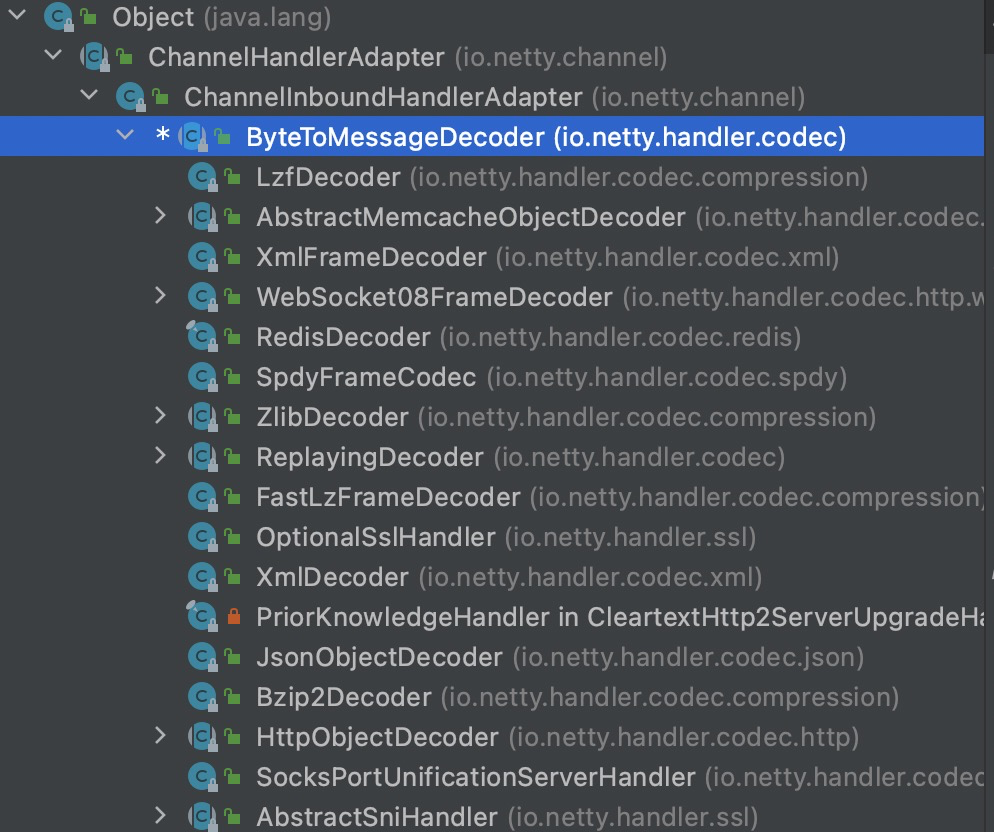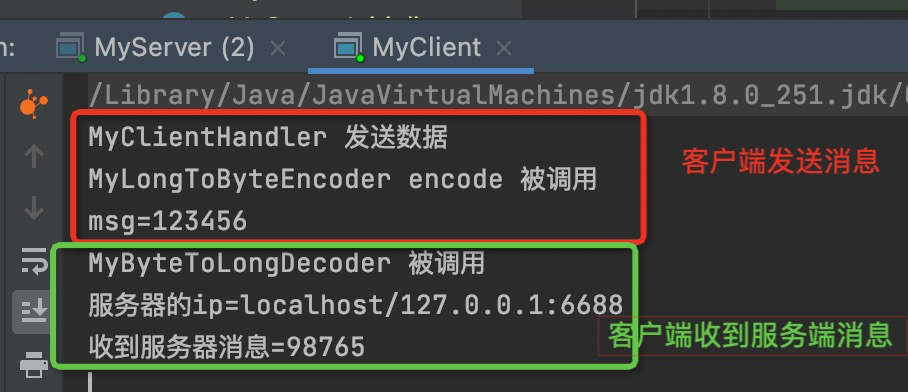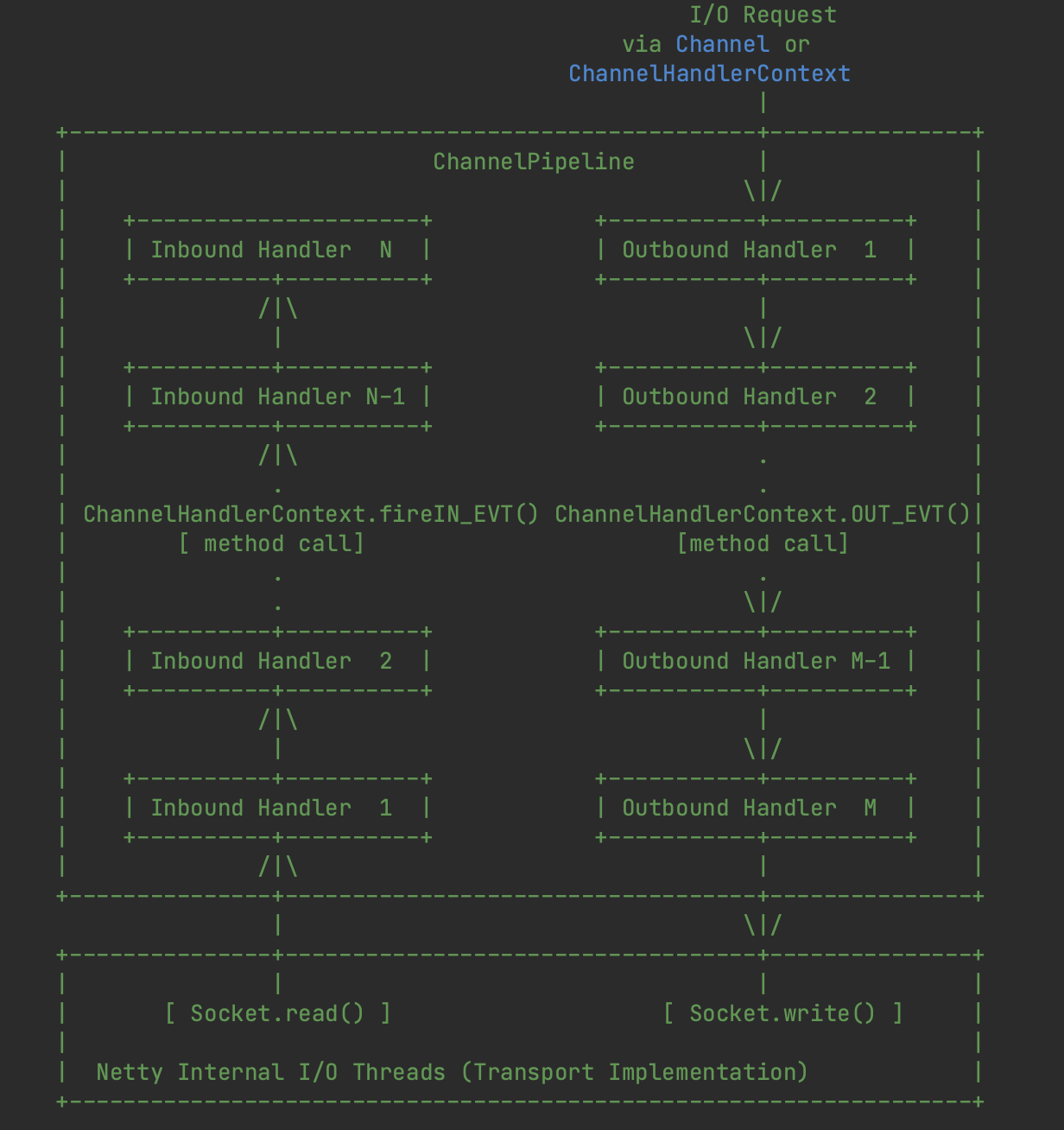一、基本说明
- Netty 的组件设计:Netty 的主要组件有 Channel、EventLoop、ChannelFuture、ChannelHandler、ChannelPipe 等。
- ChannelHandler 充当了处理入站和出站数据的应用程序逻辑的容器。例如,实现 ChannelInboundHandler 接口(或 ChannelInboundHandlerAdapter),你就可以接收入站事件和数据,这些数据会被业务逻辑处理。当要给客户端发送响应时,也可以从 ChannelInboundHandler 冲刷数据。业务逻辑通常写在一个或者多个 ChannelInboundHandler 中。ChannelOutboundHandler 原理一样,只不过它是用来处理出站数据的。
- ChannelPipeline 提供了 ChannelHandler 链的容器。以客户端应用程序为例,如果事件的运动方向是从客户端到服务端的,那么我们称这些事件为出站的,即客户端发送给服务端的数据会通过 pipeline 中的一系列 ChannelOutboundHandler,并被这些 Handler 处理,反之则称为入站的。
二、编码解码器
- 当 Netty 发送或者接受一个消息的时候,就将会发生一次数据转换。入站消息会被解码:从字节转换为另一种格式(比如 java 对象);如果是出站消息,它会被编码成字节。
所以,编码器都是继承的 ChannelOutboundHandlerAdapter。解码器都是继承的ChannelInboundHandlerAdapter。如下
解码器—》入站
编码器—》出站
Netty 提供一系列实用的编解码器,他们都实现了 ChannelInboundHadnler 或者 ChannelOutboundHandler 接口。在这些类中,channelRead 方法已经被重写了。以入站为例,对于每个从入站 Channel 读取的消息,这个方法会被调用。随后,它将调用由解码器所提供的 decode() 方法进行解码,并将已经解码的字节转发给 ChannelPipeline 中的下一个 ChannelInboundHandler。
三、解码器 - ByteToMessageDecoder

由于不可能知道远程节点是否会一次性发送一个完整的信息,tcp 有可能出现粘包拆包的问题,这个类会对入站数据进行缓冲,直到它准备好被处理.【后面有说TCP的粘包和拆包问题】。
- 一个关于 ByteToMessageDecoder 实例分析。


in.readInt()每次读取四个字节,假设 [3,7,9,2]是代表四个字节,那个每次读取四个字节就会放入到 list中。
关于 基本数据类型的的大小,参考 https://www.yuque.com/wangchao-volk4/fdw9ek/qk2yt8#tUBlY
四、Netty 的handler链的调用机制
1、实例要求
- 使用自定义的编码器和解码器来说明 Netty 的 handler 调用机制 客户端发送 long -> 服务器,服务端发送 long -> 客户端。
2、代码部分
MyClient
public class MyClient {public static void main(String[] args) throws InterruptedException {NioEventLoopGroup group = new NioEventLoopGroup();try {Bootstrap bootstrap = new Bootstrap();bootstrap.group(group).channel(NioSocketChannel.class).handler(new MyClientInitializer());ChannelFuture channelFuture = bootstrap.connect("localhost", 6688).sync();channelFuture.channel().closeFuture().sync();} finally {group.shutdownGracefully();}}}
MyClientInitializer
public class MyClientInitializer extends ChannelInitializer<SocketChannel> {@Overrideprotected void initChannel(SocketChannel ch) throws Exception {ChannelPipeline pipeline = ch.pipeline();// 加入一个出站的 handler 对数据进行一个编码pipeline.addLast(new MyLongToByteEncoder());// 入站的 handler 进行解码,MyByteToLongDecoderpipeline.addLast(new MyByteToLongDecoder());// 加入一个自定义的 handler,处理业务逻辑pipeline.addLast(new MyClientHandler());}}
MyClientHandler
public class MyClientHandler extends SimpleChannelInboundHandler<Long> {@Overrideprotected void channelRead0(ChannelHandlerContext ctx, Long msg) throws Exception {System.out.println("服务器的ip=" + ctx.channel().remoteAddress());System.out.println("收到服务器消息=" + msg);}// 重写 channelActive 发送数据@Overridepublic void channelActive(ChannelHandlerContext ctx) throws Exception {System.out.println("MyClientHandler 发送数据");ctx.writeAndFlush(123456L); // 发送的是一个 Long// 分析// 1、 adadadadadadadad 16个字节// 2、该处理器的前一个 handler 是 MyLongToByteEncoder// 3、MyLongToByteEncoder 父类 MessageToByteEncoder// 4、父类 MessageToByteEncoder 有个 write 方法(判断当前msg 是不是应该处理的类型,如果是就处理,如果不是就跳过encoder)/*** @Override* public void write(ChannelHandlerContext ctx, Object msg, ChannelPromise promise) throws Exception {* ByteBuf buf = null;* try {* if (acceptOutboundMessage(msg)) { // 判断当前msg 是不是应该处理的类型,如果是就处理,如果不是就跳过encoder* @SuppressWarnings("unchecked")* I cast = (I) msg;* buf = allocateBuffer(ctx, cast, preferDirect);* try {* encode(ctx, cast, buf);* } finally {* ReferenceCountUtil.release(cast);* }** if (buf.isReadable()) {* ctx.write(buf, promise);* } else {* buf.release();* ctx.write(Unpooled.EMPTY_BUFFER, promise);* }* buf = null;* } else {* ctx.write(msg, promise);* }* } catch (EncoderException e) {* throw e;* } catch (Throwable e) {* throw new EncoderException(e);* } finally {* if (buf != null) {* buf.release();* }* }* }*/// 5、因此我们编写 encoder 时,要注意传入的数据类型和处理的数据类型要一致// ctx.writeAndFlush(Unpooled.copiedBuffer("adadadadadadadad", CharsetUtil.UTF_8));}}
MyByteToLongDecoder
public class MyByteToLongDecoder extends ByteToMessageDecoder {/*** decode 会根据接收的数据,被调用多次,直到确定没有新的元素被添加到 list,或者是 ByteBuf 没有更多的可读字节为止* 如果 List out 不为空,就会将list 的内容传递给下一个 channelinboundhandler 处理,该处理器的方法也会被调用多次。* @param ctx 上下文对象* @param in 入站的 ByteBuffer* @param out List 集合,将解码后的数据传给下一个 handler* @throws Exception*/@Overrideprotected void decode(ChannelHandlerContext ctx, ByteBuf in, List<Object> out) throws Exception {System.out.println("MyByteToLongDecoder 被调用");// 因为 Long 8个字节,必须判断有八个字节才能读取一个Longif (in.readableBytes() >= 8) {out.add(in.readLong());}}}
MyLongToByteEncoder
public class MyLongToByteEncoder extends MessageToByteEncoder<Long> {/*** 编码的方法** @param ctx* @param msg* @param out* @throws Exception*/@Overrideprotected void encode(ChannelHandlerContext ctx, Long msg, ByteBuf out) throws Exception {System.out.println("MyLongToByteEncoder encode 被调用");System.out.println("msg=" + msg);out.writeLong(msg);}}
MyServer
public class MyServer {public static void main(String[] args) throws InterruptedException {NioEventLoopGroup bossGroup = new NioEventLoopGroup(1);NioEventLoopGroup workerGroup = new NioEventLoopGroup();try {ServerBootstrap serverBootstrap = new ServerBootstrap();serverBootstrap.group(bossGroup,workerGroup).channel(NioServerSocketChannel.class)// 自定义一个初始化类.childHandler(new MyServerInitializer());ChannelFuture channelFuture = serverBootstrap.bind(6688).sync();channelFuture.channel().closeFuture().sync();}finally {bossGroup.shutdownGracefully();workerGroup.shutdownGracefully();}}}
MyServerHandler
public class MyServerHandler extends SimpleChannelInboundHandler<Long> {@Overrideprotected void channelRead0(ChannelHandlerContext ctx, Long msg) throws Exception {System.out.println("从客户端" + ctx.channel().remoteAddress() + " 读取到long:" + msg);// 给客户端发送一个Longctx.writeAndFlush(98765L);}@Overridepublic void exceptionCaught(ChannelHandlerContext ctx, Throwable cause) throws Exception {cause.printStackTrace();ctx.channel();}}
MyServerInitializer
public class MyServerInitializer extends ChannelInitializer<SocketChannel> {@Overrideprotected void initChannel(SocketChannel ch) throws Exception {ChannelPipeline pipeline = ch.pipeline();// 入站的 handler 进行解码,MyByteToLongDecoderpipeline.addLast(new MyByteToLongDecoder());// 出站 handler 进行编码,MyLongToByteEncoderpipeline.addLast(new MyLongToByteEncoder());// 自定义的 handler 处理业务逻辑pipeline.addLast(new MyServerHandler());}}
3、注意点
父类 MessageToByteEncoder 有个 write 方法(判断当前msg 是不是应该处理的类型,如果是就处理,如果不是就跳过encoder)。因此我们编写 encoder 时,要注意传入的数据类型和处理的数据类型要一致。
public void write(ChannelHandlerContext ctx, Object msg, ChannelPromise promise) throws Exception {ByteBuf buf = null;try {// 这里会判断if (this.acceptOutboundMessage(msg)) {I cast = msg;buf = this.allocateBuffer(ctx, msg, this.preferDirect);try {this.encode(ctx, cast, buf);} finally {ReferenceCountUtil.release(msg);}if (buf.isReadable()) {ctx.write(buf, promise);} else {buf.release();ctx.write(Unpooled.EMPTY_BUFFER, promise);}buf = null;} else {ctx.write(msg, promise);}} catch (EncoderException var17) {throw var17;} catch (Throwable var18) {throw new EncoderException(var18);} finally {if (buf != null) {buf.release();}}}
4、分析输出结果
客户端
服务端
分析

- 客户端有出站入站,服务端也有出站入站。
- 以客户端为例,如果有服务端传送的数据到达客户端,那么对于客户端来说就是入站; 如果客户端传送数据到服务端,那么对于客户端来说就是出站; 同理,对于服务端来说,也是一样的,有数据来就是入站,有数据输出就是出站 。
- 为什么服务端和客户端的Serverhandler都是继承 SimpleChannelInboundHandler,而没有继承ChannelOutboundHandler 出站类? 实际上当我们在handler中调用ctx.writeAndFlush()方法后,就会将数据交给 ChannelOutboundHandler 进行出站处理,只是我们没有去定义出站类而已,若有需求可以自己去实现ChannelOutboundHandler 出站类 。
- 总结就是客户端和服务端都有出站和入站的操作
- 服务端发数据给客户端:服务端—->出站—->Socket通道—->入站—->客户端
- 客户端发数据给服务端:客户端—->出站—->Socket通道—->入站—->服务端
- io.netty.channel.ChannelPipeline 也给出一些 图
五、其他编解码器
1、解码器 - ReplayingDecoder
- public abstract class ReplayingDecoder
extends ByteToMessageDecoder。 ReplayingDecoder 扩展了 ByteToMessageDecoder 类,使用这个类,我们不必调用 readableBytes() 方法,也就不用判断还有没有足够的数据来读取。参数 S 指定了用户状态管理的类型,其中 Void 代表不需要状态管理。应用实例:使用 ReplayingDecoder 编写解码器,对前面的案例进行简化[案例演示]。public class MyByteToLongDecoder2 extends ReplayingDecoder<Void> {@Overrideprotected void decode(ChannelHandlerContext ctx, ByteBuf in, List<Object> out) throws Exception {System.out.println("MyByteToLongDecoder 被调用");// 因为 Long 8个字节,必须判断有八个字节才能读取一个Longout.add(in.readLong());// 这步不需要了// if (in.readableBytes() >= 8) {// out.add(in.readLong());// }}}
ReplayingDecoder 使用方便,但它也有一些局限性:LineBasedFrameDecoder:这个类在 Netty 内部也有使用,它使用行尾控制字符(\n或者\r\n)作为分隔符来解析数据。DelimiterBasedFrameDecoder:使用自定义的特殊字符作为消息的分隔符。HttpObjectDecoder:一个 HTTP 数据的解码器LengthFieldBasedFrameDecoder:通过指定长度来标识整包消息,这样就可以自动的处理黏包和半包消息。
解码器。。。
编码器。。。






